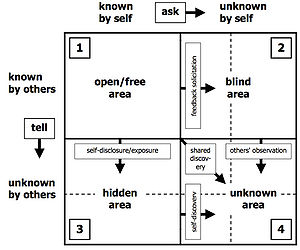Managing Group Development using the Johari Window
The Johari Window is a psychological model for effective group development and self-awareness and plants its roots in the human behavioral phenomenon. Failing to manage group development can result in ineffective group communication, and hence be the source of various downfalls of project execution, streaming from prevention of information sharing to decreased performance and unproductiveness. In order to prevent these circumstances, it is important for each project member to embrace self-awareness, enable dynamics and create effective group development.
In this article the Johari Window will be discussed as a means to prevent ineffective group development and increase effective group communication. A valuable insight into the framework and purpose of the Johari Window will be given in which the four quadrants will be described thoroughly. Additionally, the Shannon-Weaver model of communication and Tuckman's stages of group development will briefly be touched upon along with the importance of feedback, to stress the necessity of managing group development, and simultaneously create a link between the models. This article draws upon psychological and managerial theories to enrich the findings, and will end with a critical view point of the Johari Window in which the limitations will be discussed.
Contents |
History

The Johari Window was developed in 1955 by American psychologists Joseph Luft (1916-2014) and Harrington Ingham (1916-1995) [1] from whom the name Johari was derived combining both of the psychologists names. It was initially a psychological tool to enhance self-awareness but continued to expand towards being a communication tool, inter-group development- and intra-group development tool, with the common purpose to enhance self-awareness, increase effective group development and demolish communication barriers.
(....)
(....)
The Johari Window and its purpose
(.....)
The 4 Quadrants
The Johari window contains four quadrants, the open/free area, blind area, hidden area and the unknown area, each with similar sizes that can further be changed based on the particular group member. The quadrants make up the window and is the foundation of the model. The four quadrants are represented in the following section.
The Open/Free Area Quadrant
When a group is developed the open/free area is small due to the lack of shared knowledge, however as the group development evolves the open/free area maximizes due to shared awareness taking place. This is particularly seen when new group members enter an already established group. This quadrant contains e.g. the behaviour, feelings, emotions, experience, skills, knowledge that is known by the individual group member and the other group members. Furthermore, it is the quadrant where group communication, collaboration, cooperation, individual effectiveness and individual productivity mostly takes place and mistrust, miscommunication, conflicts and confusion is downsized or barely existing.
The Blind Area Quadrant
When an individual is located in the blind area the information about oneself is unknown but known for the rest of the group members. This area is often referred to as the bad breath describing how other feel the smell but the individual does not (ref). It is tainted with unproductiveness and decreased effectiveness. The initial jump from this area is to reduce it and increase the open/free area through increasing self-awareness within the group. Another aspect of this area is that other group members purposely withholds information towards other group members and hence continuing the group development and/or group projects with individuals lacking information and consequently decreased motivation.
The Hidden Area Quadrant
This area represents an individual’s private information that is hidden from the rest of the group. Private information contains e.g. fears, secrets, hurt, bad intentions and motives, work related information that the individual does not want exposed and thus does not deliberately reveal. This area typically hinders performance due to the extent of hidden information that could relatively be an important factor for both group development and further a group’s effectiveness. That is not to say that all private and personal information should be exposed, it is thus the project manager’s role to steer a project group towards revealing information according to relevance and necessity. The aim in this area is to reduce the hidden area and hence demolish e.g. ineffective group communication, confusion, mistrust and misunderstanding and increase the open/free area through moving relevant information into it to increase effectiveness, productive and a mutual understanding.
The Unknown Area Quadrant
This area represents an individual’s behaviour, information, feelings, experiences, attitudes, capabilities and skills that are unknown to oneself and to the group. Relatively common unknown factors have been identified as being the following (ref):
- An ability or skill that is under-estimated due to the lack of opportunity, encouragement, confidence or training.
- A natural ability or skill that an individual does not realise they possess.
- A fear or subconscious feelings that an individual does not know they have.
- A conditioned behaviour or attitudes from an individual’s childhood.
The unknown factors can- if known- be used to great advantage within a group both to enhance competitive advantage and increase group effectiveness and efficiency.
Group Development
Forming
Storming
Norming
Performing
Adjourning
Communication channels and the Johari Window
Application
(.....)
Limitations
(.....)
Annotated Bibliography
References
- ↑ Wikipedia. Johari Window. Retrieved 10 September 2016.